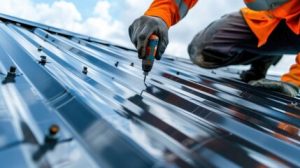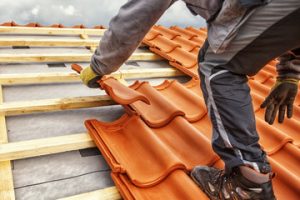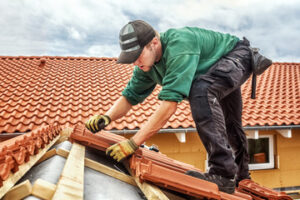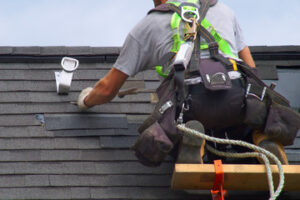The roof is an important part of any building, offering protection and insulation. There are many different types of roofing materials, each with their own advantages and disadvantages.

A new roof starts with a thorough inspection to check for damage and sheathing. Then, the roofer lays a layer of underlayment, such as felt or asphalt. They also install ice and water barriers at the eaves and flashing around chimneys and vents. Get a Free Quote Today by reading the article below.
The type of roofing material you choose for your roof has a significant impact on the price, longevity and appearance of your home. Modern roofing materials come in a wide variety of colors and styles to suit any design taste. A new roof can add curb appeal and boost your property value.
Choosing the right roofing materials for your climate is crucial to prevent damage and save on energy costs. For example, metal roofs are durable and long-lasting, while asphalt shingles provide insulation and weather resistance. In addition, certain shingle varieties feature reflective properties to reduce cooling bills in sunny areas.
Sheathing materials include plywood and oriented strand board (OSB). They provide a stable base under the roofing material and help maintain the structural integrity of the roof. Plywood and OSB also have fire-retardant properties. In addition, these materials are easy to work with and offer a high level of flexibility for the roof structure.
Other popular roofing materials include wood shingles and tiles. Many types of wood shingles have a natural look and work well with many home designs. However, they are prone to rot and require regular maintenance and replacement. Tile is a more durable option, but it can be heavy and requires a strong roof structure to support its weight. It’s important to consult a professional to determine whether your house can support a tile roof.
If you’re building a new home, a metal roof is an excellent choice for its durability and longevity. It can last up to 80 years and offers an eco-friendly alternative to other common roof coverings like asphalt shingles. Metal roofs also protect against rain and hail and are durable against wind and snow.
If you’re replacing an existing roof, asphalt shingles are a versatile and affordable roofing option. They are available in a wide range of architectural styles, including 3-tab shingles and premium shingles that replicate the authentic look of other types of roofs, such as slate or cedar shakes. Some shingle brands even include features that make them resistant to the elements, such as UV radiation and harsh weather conditions.
Installation Methods
A roofing installation is a big project that requires professional guidance. If not done properly, leaks and other damage could occur inside the home. Having an experienced roofer perform the work will ensure that all industry standards and manufacturer specifications are met. The process involves removing the old materials (if necessary), cleaning the roof deck, and applying underlayment and flashing before installing the new material. The final step involves a complete inspection and sealing.
Before the actual roofing material is applied, a self-stick underlayment is installed. This protects the roof deck from moisture, and also creates a waterproof barrier at the roof’s perimeter. Attention is then turned to the flashing, which is used to prevent water infiltration around roof joints and valleys, as well as at the junctions of the roof with other structures like chimneys and vents. A drip edge is also placed along the bottom of the roofing to further enhance its waterproof capabilities.
When a new roof is being installed over an existing one, a batten system is often used. This is a 2’x2′ grid that provides an even surface for the new material to adhere to. It’s important to properly install the batten system and inspect it for any cracks, dents or other irregularities that might compromise the integrity of the new roof.
Metal roofing is typically installed using either through-fastener or clip-fastener systems. Through-fastener systems utilize exposed screws that pass through the overlapping panels, whereas clip-fastener systems use specialized clips to attach to the panel or shingle and conceal the fastener. Exposed fasteners are more susceptible to weathering and may fail much sooner than concealed ones.
If a ridge vent is being installed, it is usually run along the top of the roof under the ridge cap and into the attic. These vents can improve airflow by creating a continuous channel through which hot air escapes. Another type of ridge vent is the power vent, which is electrically powered and moves air through a fan that is rotated by wind. Proper insulation and ventilation will help to reduce energy costs and keep the interior of the home comfortable year-round.
Safety
Working on roofs presents many safety hazards that must be addressed and mitigated. These risks include falls, weather conditions, and structural issues. Taking the proper precautions and utilizing the right equipment helps ensure the project is completed without any interruptions or delays.
The first step in ensuring roofing installation is safe is to prepare the area. This includes securing the work zone and removing any items that may interfere with the crew’s access to the roof. It also means installing protective coverings to shield windows, plants, and other areas from rain, snow, or other inclement weather.
Ladders are an integral part of the roofing process, but they can present safety risks if not used properly. A good rule of thumb is to place ladders on stable and level surfaces, secure them, and keep the base a quarter of the working length from the wall. When climbing, always face the ladder and maintain three points of contact (two feet and a hand or two hands and a foot).
Using the right tools and equipment for each phase of the job is essential to prevent injuries. This includes selecting the right ladders for the job and ensuring they’re not overloaded. In addition, all workers should be trained on how to use ladders safely and to perform regular inspections of their equipment. Having basic first-aid supplies on site is also crucial to addressing minor injuries or accidents that occur.
Falling is one of the leading causes of injury for roofers, and it’s almost always preventable. This is why OSHA created their Fall Prevention Campaign to educate workers on the best practices for avoiding falls while working at heights.
Other common hazards of roofing work include electrical mishaps, slippery roofs, and tool-related injuries. These injuries can be serious if not treated immediately, so it’s important for contractors to follow proper safety guidelines when working on roofs. They should also be familiar with local building regulations and permit requirements to avoid any legal complications or unnecessary delays. They should also take the time to develop a contingency plan for any unforeseen challenges that arise during the project.
Warranty
Roofing systems represent significant investments for property owners, and they need to last long enough to pay off the initial investment. To protect their investments, many homeowners opt to purchase a roof warranty that provides coverage in the event of problems. However, these warranties differ in terms of coverage and duration, and it is essential to understand them in order to make the right choice.
Generally speaking, manufacturers offer two types of roof warranties: a material warranty and a workmanship warranty. A manufacturer’s material warranty covers defects in the materials that comprise a roofing system, including shingles or membranes. A contractor’s workmanship warranty, on the other hand, covers errors in installation and may also include labor costs for repairs. A roofing company may also offer an enhanced warranty that provides increased protection for their customers, such as GAF’s Golden Pledge Warranty, which offers full replacement cost and no dollar limit on both materials and labor.
When choosing a warranty, property owners must consider the length of time it covers and whether the warranty is prorated or non-prorated. Prorated warranties reduce the amount of coverage over the years, while non-prorated ones provide full coverage until they expire. In addition, some warranties require regular inspections and maintenance to remain valid, while others may exclude certain types of damage. In addition, some manufacturers may not allow a transferable warranty to be transferred if the property changes hands within a specified period of time.
Aside from evaluating the length of a warranty, property owners should also read the fine print to ensure that they understand the terms and conditions. Most importantly, they should ensure that their roofing contractors are licensed and certified, as failure to do so could void the warranty. In addition, it is advisable to keep records of all inspections and maintenance performed on the roofing system.
Regular maintenance of a roofing system helps to prolong its lifespan and prevents the need for costly repair or replacement. Proper maintenance includes cleaning gutters regularly and removing debris, which can avoid clogs and water backups, as well as trimming tree branches to prevent the risk of damage from falling leaves or branches. In addition, scheduling routine inspections by a professional can help to detect and address problems quickly.


